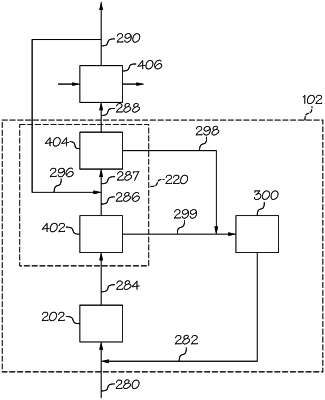| CPC C07C 5/3337 (2013.01) [C07C 2523/08 (2013.01); C07C 2523/42 (2013.01); C07C 2523/62 (2013.01)] | 19 Claims |

|
1. A method comprising:
introducing a hydrocarbon feed stream into a reactor, wherein the reactor comprises at least one reactor section operating as a fast fluidized, turbulent, or bubbling bed upflow reactor or a dilute phase riser reactor;
reacting the hydrocarbon feed stream with a dehydrogenation catalyst in the reactor to form a high temperature dehydrogenated product having a temperature of at least 550° C., the dehydrogenated product comprising at least a portion of the hydrocarbon feed stream that was not catalytically reacted;
separating at least a portion of the dehydrogenation catalyst from the high temperature dehydrogenated product in a primary separation device, wherein the temperature of the dehydrogenated product and dehydrogenation catalyst in the primary separation device is at least 550° C.;
following the exit of a high temperature dehydrogenation product from the primary separation device, combining the high temperature dehydrogenation product with a quench stream to cool the high temperature dehydrogenation product and form an intermediate temperature dehydrogenation product, and wherein a temperature of the intermediate temperature dehydrogenation product is at least 10° C. less than a temperature of the high temperature dehydrogenation product, and wherein the temperature of the high temperature dehydrogenation product is about equivalent to the temperature of the high temperature dehydrogenated product; and
cooling the intermediate temperature dehydrogenation product to form a cooled dehydrogenation product, wherein a portion of the cooled dehydrogenation product is utilized as at least a portion of the quench stream.
|